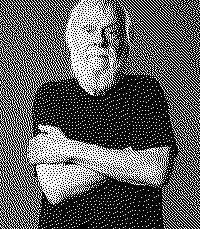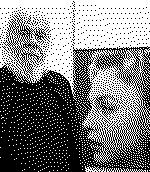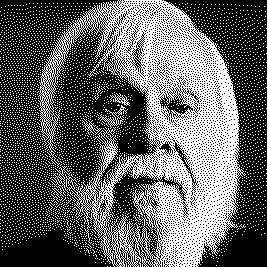Artists/John Baldessari
Fast Facts
Pioneering Conceptual Artist
Baldessari is often regarded as a pioneer of conceptual art, a movement that emerged in the 1960s emphasizing the idea behind a work of art over its aesthetic or material form.
Use of Photography and Text
He was known for combining photography and text in his artworks. His innovative use of found photography and appropriated images, often taken from film stills and other popular media, challenged traditional notions of authorship and originality in art.
Distinctive Humor and Style
His work is recognizable for its often humorous, ironic approach, and his use of colorful dot stickers to obscure faces in photographs became a signature element in many of his pieces.
Iconic "Cremation Project"
In 1970, Baldessari undertook one of his most famous actions, the "Cremation Project," where he cremated all the paintings he had created between 1953 and 1966. The ashes were baked into cookies and placed in an urn, accompanied by a bronze plaque with the birth and death dates of the paintings.
Biography



John Baldessari was a pioneering American conceptual artist, known for his inventive integration of photography, text, and other media into his artworks.
Born on June 17, 1931, in National City, California, he grew up during the Great Depression, an experience that played a role in shaping his creative outlook. His early life was marked by an environment of thrift and resourcefulness, influenced by his parents' diverse backgrounds and his father's entrepreneurial ventures.
Baldessari's academic journey began at San Diego State College, where he initially studied art education before shifting his focus to art history and eventually earning an MA in painting in 1957. His early career as an educator, combined with his isolation from major art scenes, allowed him the freedom to experiment and develop his unique artistic voice.
His work took a significant turn in the mid-1960s when he started incorporating text and photography into his canvases, exploring the intersection of language and image in a way that challenged traditional notions of art. One of his hallmark early works involved canvases that featured nothing but painted statements derived from contemporary art theory, aiming to question the essence and reception of art itself.
A notable moment in Baldessari's career was "The Cremation Project" in 1970, where he burnt all of the paintings he had created up to that point. This act of destruction and renewal was emblematic of his approach to art-making, which often involved recontextualizing familiar elements to explore new meanings. Following this, his work increasingly featured the use of appropriated images and text, pushing the boundaries of conceptual art.
Baldessari's later work continued to play with the juxtaposition of image and text, as well as the concept of pointing—directing the viewer's attention in specific ways to challenge perceptions and interpretations of art. From the late 1980s onwards, he famously used adhesive dots to cover faces in photographs, a method that invited viewers to look beyond conventional focal points and consider the broader implications of the image.
Throughout his career, Baldessari was also a significant figure in art education, influencing generations of artists with his innovative ideas and practices. He passed away on January 2, 2020, leaving behind a legacy that has profoundly impacted contemporary art. His work is celebrated for its wit, critical engagement with the art-making process, and its exploration of how information and meaning are constructed and conveyed (Wikipedia) (The Art Story).
Series
-

Wrong
-

National City
1966–1968
-

Commissioned Paintings
1969
-

Text Paintings
1966–1968
-

California Map Project
1969
-

Throwing Three Balls In The Air to Get a Straight Line
1973
-

Blasted Allegories
1978
-

Choosing (A Game for Two Player: Carrots)
1972
-

The Difference Between Fête and Fate
1987–2013
-

Installation Works
-

The Life and Opinions of Tristram Shandy, Gentleman
1988
-

Goya
1997
-

Tetrad
1999
-

Overlap
2000–2003
-

Intersections
-

Junctions
-

Prima Facie
2005
-

Blockage (Yellow)
2005
-

Noses & Ears, Etc.
-

Arms & Legs
2007
-

Raised Eyebrows/Furrowed Foreheads
2008
-

Ear Sofa; Nose Sconces with Flowers (In Stage Setting)
-

Hands and/or Feet (part one)
2009
-

Hands and/or Feet (part two)
2009–2010
-

Sediment (Part Two)
-

Guitars
2010
-

Double Feature
2011
-

Double Bill
2012
-

Double Play
2012–2014
-

Storyboard (in 4 parts)
2013
-

Movie Scripts/Art
2014
-

Pictures and Scripts
2015
-

Pollock/Benton
2016
-

Miró and Life in General
2016
-

Emojis
-

Eight Colorful Inside Jobs
2017
-

All Z’s (Picabia/Mondrian)
2017
-

Hot & Cold
2018
-

Brain/Cloud
2019
-

The Space Between
2019–2020
-

The Story Underneath
Importance
John Baldessari's importance in the art world is manifold, reflecting a career that not only challenged but also reshaped the boundaries of conceptual art. His contributions can be summarized across several key areas:
Innovative Use of Media
Baldessari's pioneering integration of text, photography, and video into his works from the mid-1960s onwards represented a significant departure from traditional painting and sculpture. His approach to art was radically open, employing found images and appropriated materials to question the nature of art itself (The Art Story).
Exploration of Language and Semiotics
Through works like "I Am Making Art" (1971), Baldessari explored the relationship between language, image, and art, questioning how much art can be reduced and simplified before it stops being art. His exploration into the nature of communication and the arbitrary connections between signifiers and the signified has had a profound influence on conceptual art (The Art Story).
Engagement with Pop Culture and Mass Media
Baldessari's art often intersected with film and pop culture, utilizing elements from Hollywood movies and other mass media to create new narratives. This engagement not only demonstrated the permeability of art and popular culture but also highlighted the artist's interest in storytelling through juxtaposition and recontextualization (Smithsonian American Art Museum).
Questioning of Authorship and Originality
By employing commercial sign painters to execute his text paintings or commissioning amateur artists for his "Commissioned Paintings" series, Baldessari interrogated the notions of artistic authorship and originality, a critique that resonated within the broader conceptual art movement (The Art Story).
Teaching and Influence
Beyond his artwork, Baldessari was a highly respected and influential educator, shaping generations of artists through his innovative teaching methods. His pedagogical approach emphasized the importance of questioning and creativity, leaving a lasting impact on both his students and the wider art community (Smithsonian American Art Museum).
Creation of Iconic Visual Strategies
Perhaps one of the most visually striking aspects of Baldessari's work was his use of brightly colored circular stickers to obscure faces in photographs, which became a signature element of his later work. This method not only challenged the viewer's perceptions but also introduced a new form of visual language that has inspired artists and popular culture alike (Smithsonian American Art Museum).
Technique
John Baldessari's art techniques evolved significantly over his career, reflecting his conceptual approach to art-making. His techniques were diverse, innovative, and often combined multiple media to challenge traditional boundaries of art.
Text and Photography Integration
In the mid-1960s, Baldessari began incorporating text and found photography into his canvases, a radical departure from traditional painting that questioned the narrative potential of images and the associative power of language within the boundaries of the artwork (MoMA).
Video and Performance
Baldessari also explored video art and performance, exemplified in works like "I Am Making Art" (1971), where he used simple gestures and spoken word to interrogate the process of art-making itself. This early engagement with video art showcased his interest in the performative aspects of conceptual art (The Art Story).
Appropriation of Found Images
A hallmark of Baldessari's work was his use of appropriated images from various sources, including movie stills and other photographic materials. By recontextualizing these images, he explored the construction of narrative and the ambiguity of interpretation (Smithsonian American Art Museum).
Juxtaposition of Image and Text
Baldessari often juxtaposed images with text to explore the relationship between visual and verbal information, playing with the viewer's perception and the meanings generated by their combination (The Art Story).
Use of Color and Geometric Shapes
In works like "Frames and Ribbon" (1988), he used flat, geometric shapes of color to alter the meaning of appropriated images, employing color to both mask and highlight specific elements of the images (The Art Story).
Dot Portraits
One of Baldessari's most iconic techniques involved placing brightly colored circular stickers over the faces in photographs to obscure their identities, forcing viewers to focus on other elements of the image. This method grew to become a significant aspect of his practice, offering a playful yet profound commentary on anonymity and the ubiquity of images (Smithsonian American Art Museum).
Printmaking and Collage
Baldessari's engagement with printmaking, film, installation, sculpture, and photography allowed him to explore the narrative possibilities of images across various mediums. His innovative use of collage techniques, particularly in his photomontages, further exemplified his interest in the layering of meaning and the manipulation of context (MoMA).
Interactive and Interpretive Works
Through works that invited viewer participation or interpretation, Baldessari engaged audiences in the creative process, encouraging them to construct their own narratives or meanings based on the elements he provided, thus blurring the lines between artist and audience (Smithsonian American Art Museum).




